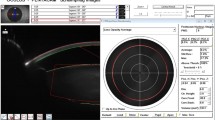Abstract
Purpose
To evaluate anterior segment parameters in patients undergoing sutureless scleral fixation intraocular lens implantation with the modified Yamane technique (SSF-IOL-MY) by using Scheimpflug camera system.
Methods
Each group of 25 patients was included for aphakia undergoing SSF-IOL-MY and for senile cataract undergoing uneventful phacoemulsification and intraocular lens implantation (Phaco+IOL). Anterior chamber depth (ACD), iridocorneal angle (ICA), anterior chamber volume (ACV) and keratometric values were evaluated by Scheimpflug camera (Sirius, CSO, Italy) system.
Results
It was seen that the ACD, ICA and ACV display wider structures in patients with SSF-IOL-MY group compared to Phaco+IOL group. However, the ACD (p = 0.828) and ICA (p = 0.219) have not a statistically significant difference, while ACV (p = 0.007) has a statistically significant difference. In terms of keratometric values of the patients, there was no statistically difference in K1, K2 and Kmax values (p = 0.348, p = 0.106, p =0.269, respectively). Although there was no statistically significant difference between the groups in terms of anterior corneal astigmatism, posterior corneal astigmatism was statistically higher in the Phaco+IOL group (p = 0.192, p = 0.031, respectively).
Conclusion
SSF-IOL-MY surgery affects anterior segment parameters similar to the Phaco+IOL method, which is the gold standard in cataract surgery. In this surgery, it was approached to the gold standard method in terms of IOL position with the ACD, ACV and ICA values and the results of the corneal incision with the keratometric values.


Similar content being viewed by others
References
Hashemi H, Khabazkhoob M, Nabovati P, Ostadimoghaddam H, Shafaee S, Doostdar A, Yekta A (2017) The prevalence of age-related eye disease in an elderly population. Ophthalmic Epidemiol 24:222–228
Porela-Tiihonen S, Kokki H, Kaarniranta K, Kokki M (2016) Recovery after cataract surgery. Acta Ophthalmol 94:1–34
Asbell PA, Dualan I, Mindel J, Brocks D, Ahmad M, Epstein S (2005) Age-related cataract. Lancet 365:599–609
Chee SP, Chan NS, Yang Y, Ti SE (2019) Femtosecond laser-assisted cataract surgery for the white cataract. Br J Ophthalmol 103:544–550
Bellucci R, Pucci V, Morselli S, Bonomi L (1996) Secondary implantation of angle-supported anterior chamber and scleral-fixated posterior chamber intraocular lenses. J Cataract Refract Surg 22:247–252
Hernández Martínez A, Almeida González CV (2018) Iris-claw intraocular lens implantation: efficiency and safety according to technique. J Cataract Refract Surg 44:1186–1191
Kara N (2015) A modified glued transscleral intraocular lens implantation: suture-assisted sutureless technique. J Refract Surg 31:488–491
Walsh MK (2017) Sutureless trocar-cannula-based transconjunctival flanged intrascleral intraocular lens fixation. Retina 37:2191–2194
Kelkar A, Kelkar J, Kothari A, Mehta H, Chitale S, Fogla R, Kelkar S (2018) Comparison of two modified sutureless techniques of scleral fixation of intraocular lens. Ophthalmic Surg Lasers Imaging Retina 49:129–134
Ucar F, Cetinkaya S (2020) Flattened flanged intrascleral intraocular lens fixation technique. Int Ophthalmol 40:1455–1460
Veronese C, Maiolo C, Armstrong GW, Primavera L, Torrazza C, Della Mora L, Ciardella AP (2020) New surgical approach for sutureless scleral fixation. Eur J Ophthalmol 30:612–615
Yamane S, Sato S, Maruyama-Inoue M, Kadonosono K (2017) Flanged intrascleral intraocular lens fixation with double-needle technique. Ophthalmology 124:1136–1142
Yavuzer K, Evcimen Y (2019) Sutureless transconjunctival intrascleral intraocular lens fixation: the modified Yamane technique. Arq Bras Oftalmol 82:389–393
Uçakhan OO, Ozkan M, Kanpolat A (2009) Anterior chamber parameters measured by the Pentacam CES after uneventful phacoemulsification in normotensive eyes. Acta Ophthalmol 87:544–548
Huang G, Gonzalez E, Peng PH, Lee R, Leeungurasatien T, He M, Porco T, Lin SC (2011) Anterior chamber depth, iridocorneal angle width, and intraocular pressure changes after phacoemulsification: narrow vs open iridocorneal angles. Arch Ophthalmol 129:1283–1290
Maggi R, Maggi C (1997) Sutureless scleral fixation of intraocular lenses. J Cataract Refract Surg 23:1289–1294
Gabor SG, Pavlidis MM (2007) Sutureless intrascleral posterior chamber intraocular lens fixation. J Cataract Refract Surg 33:1851–1854
Agarwal A, Kumar DA, Jacob S, Baid C, Agarwal A, Srinivasan S (2008) Fibrin glue-assisted sutureless posterior chamber intraocular lens implantation in eyes with deficient posterior capsules. J Cataract Refract Surg 34:1433–1438
Rocke JR, McGuinness MB, Atkins WK, Fry LE, Kane JX, Fabinyi DCA, Yeoh J, Chiu D, Essex Mbiostat RW, Roufail E, Sheridan AM, Allen PJ, Edwards TL (2020) Refractive outcomes of the yamane flanged intrascleral haptic fixation technique. Ophthalmology 127:1429–1431
Altan C, Bayraktar S, Altan T, Eren H, Yilmaz OF (2004) Anterior chamber depth, iridocorneal angle width, and intraocular pressure changes after uneventful phacoemulsification in eyes without glaucoma and with open iridocorneal angles. J Cataract Refract Surg 30:832–838
Shekhawat N, Goyal K (2017) Sutureless glueless intrascleral fixation of posterior chamber intraocular lens: Boon for aphakic. Indian J Ophthalmol 65:1454–1458
Ben Simon GJ, Desatnik H (2005) Correction of pre-existing astigmatism during cataract surgery: comparison between the effects of opposite clear corneal incisions and a single clear corneal incision. Graefes Arch Clin Exp Ophthalmol 243:321–326
Ren Y, Fang X, Fang A, Wang L, Jhanji V, Gong X (2019) Phacoemulsification with 3.0 and 2.0 mm opposite clear corneal incisions for correction of corneal astigmatism. Cornea 38:1105–1110
Author information
Authors and Affiliations
Corresponding author
Additional information
Publisher's Note
Springer Nature remains neutral with regard to jurisdictional claims in published maps and institutional affiliations.
Rights and permissions
About this article
Cite this article
Yavuzer, K., Yavuzer, B. Evaluation of anterior segment structures with Scheimpflug camera in patients undergoing sutureless scleral fixation by modified Yamane technique. Int Ophthalmol 42, 645–651 (2022). https://doi.org/10.1007/s10792-021-02107-2
Received:
Accepted:
Published:
Issue Date:
DOI: https://doi.org/10.1007/s10792-021-02107-2




